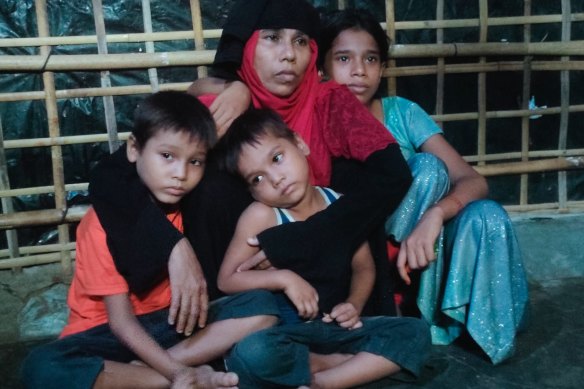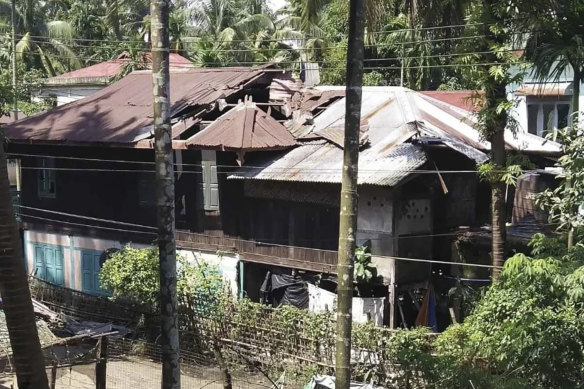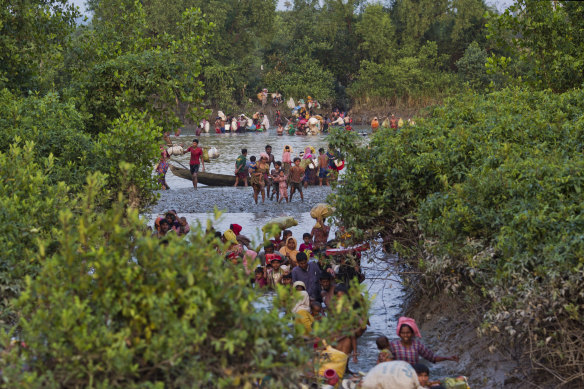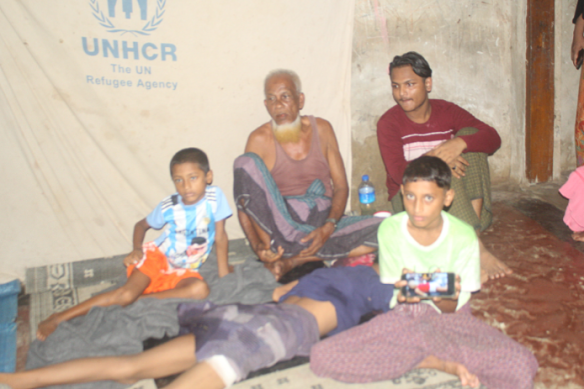By Zach Hope and Saiful Arakani
Warning: Graphic content
Bangkok: Survivors of what appears to be a massacre of civilians in Myanmar have recounted seeing hundreds of people, including an unknowable number of children, slaughtered in indiscriminate drone attacks near the water border with Bangladesh.
Squeezed to the riverbanks by the deadly shelling of Maungdaw town in Rakhine State, members of the Rohingya Muslim minority claimed they were targeted by the Arakan Army (AA), a powerful ethnic group warring with both the military junta and “extremist Muslim armed groups”.

Rohingya woman Noyona Khantun and her surviving children reached Bangladesh on Saturday after hiding for days on the Myanmar side of the border. Credit: Saiful Arakani
The attacks happened on August 5, but details are now only starting to emerge, such is the chaos of civil war in Myanmar and the inability of non-government organisations to reach the worst-hit areas.
AA, the military wing of the state’s Rakhine ethnic group, denied responsibility for the assault on Rohingya trying to flee fierce fighting in the town by crossing the Naf River into Bangladesh.
Gruesome videos circulating on social media and purportedly filmed near Maungdaw in the aftermath of the strikes show dozens of mangled bodies of men, women and children on the estuarine mudflats. Another video shows masses of panicked people in the water and on land.

A view of the roof of a house damaged by bombs dropped from a drone in Ali village in Maungdaw township.Credit: AP
Neither the video nor details of the attack can be easily verified due to tight restrictions on travel and ongoing combat in the area.
“I saw many killed, more than 400,” Noyona Khantun told this masthead on a video call from her shelter near the Teknaf border point in Bangladesh. “The dogs and crows were eating the putrid bodies.”
Khantun, 40, said her 10-year-old daughter was among the dead. Other family members had been abducted, their fates unknown, she said.
She and her surviving family made it to Bangladesh on Saturday, having hidden by the riverbank for several days before fleeing on a dinghy.

Groups of Rohingya Muslims cross the Naf River at the border between Myanmar and Bangladesh, near Palong Khali, Bangladesh in 2017.Credit: AP
Mohammed Hubaib, a 12-year-old from a different family, also estimated he saw the bodies of about 400 people, some of whom had drowned after their boats were attacked during the crossing. His grandfather, 70-year-old Mohammed Kasim, said he “witnessed the AA drone strikes kill more than 250 Rohingya in front of me, including children and women” before he passed out.
A boy sheltering with Kasim at Teknaf is so ill he cannot speak or move.
In addition to the drone attacks by the riverbanks, more than 100 Rohingya may have been killed in Maungdaw town, which is now believed to be clear of junta forces. Reports are also emerging from survivors in Bangladesh that people were drowned or remained captives of pirates who had presented themselves as rescuers, only to hold the escapees to ransom.
In a statement, the AA said, “we respectfully announce that these deaths did not occur in areas under our control and are not related to our organisation.” The group continued to fight the regime and the “extremist” Muslim groups, which were using “weapons and manpower to … prevent innocent civilians from reaching safe places.”
The AA and military junta both view the Muslim Rohingya as unwelcome interlopers from Bangladesh, though families have lived in Myanmar for generations.
Allegations of abuses by the AA are controversial because the group’s armed force has played a major role in winning battlefield victories for the resistance movement against military rule. There is much credible evidence of atrocities carried out by the military government’s forces, but reported abuses by resistance groups have been minimal.
International aid group Médecins Sans Frontières (MSF) in Bangladesh said it had treated more than 50 people in the last week for injuries consistent with a war zone.
“We’re talking about gunshots, land mines, mortar shells,” deputy Bangladesh representative Anthony Caswell Perez said.
“This is indicative of an escalation of violence in Rakhine. To actually be able to comment on what’s happening on the other side is very difficult because we don’t have a presence in Rakhine State at the border. But something is happening.
“And considering that over half of the patients that we have treated are children and women, that is indicative of indiscriminate attacks against civilians.”
MSF earlier said it had received witness reports of “hundreds” of people killed, but the toll remains unverified. If confirmed, the incident would mark one of the worst atrocities since the 2021 military coup that ousted the elected government of Aung San Suu Kyi.
Witnesses have said thousands more Rohingya had been attempting to get into Bangladesh from Maungdaw, but had been blocked on the water by junta vessels and on land by Bangladeshi authorities.
The Rohingya are among the world’s most persecuted people – even Suu Kyi, a Nobel Peace Prize laureate with legions of supporters around the world, refused to stand up for the Rohingya during a brutal 2017 military crackdown alleged at the International Court of Justice to be genocide.

Mohammed Kasim (centre, in singlet) with family members, including 12-year-old Mohammed Hubaib (sitting at the front), by a UNHCR banner at their shelter in Teknaf, Bangladesh. The boy lying down is so ill he cannot move and has urinated and defecated in his clothes. Credit: Saiful Arakani
Fighting has intensified in Myanmar since offensives by rebel groups in October last year. In a serious blow, the regime appears to have recently lost the Shan State city of Lashio, home of the north-eastern command. While its forces remain strong in the major cities of the lowlands, elsewhere they have suffered serious losses of ground, personnel and morale. Desperation has manifested in policies of forced conscriptions and attacks on civilian areas.
The UN reported in June that at least 5280 civilians, more than a third of them women and children, had been killed by the military junta since the coup. Close to three million people were internally displaced and more than 20,000 who had stood up to the regime remained in detention.
The alleged brutality of the AA toward the minority Rohingya, however, underscores how separating good from the bad in the contest with myriad competing interests and complex historical antecedents is not straightforward.
ASEAN’s response – the “five-point consensus”, which regime leader Min Aung Hlaing has reneged on – has been ineffective. Following a meeting of foreign ministers in Laos last month, the regional bloc committed to the same plan again and congratulated itself on the delivery of $US1.9 million worth of aid.
Delivery of vital services has been stymied by the fighting and the junta’s control of major access routes and the levers of government. Even so, aid agencies say they can make a difference and have pleaded for the international community to do more.
“Even basic health services have collapsed,” said Samuel David Theodore of MSF in Myanmar, citing the states of Rakhine, Kachin and northern Shan as the worst affected.
“People don’t have access to vaccinations or drugs. Women and their babies are dying because they can’t get Caesarean sections. Children are dying from conditions that would be treated easily in any functional hospital.”
The UN’s own 2024 Humanitarian Response Plan for Myanmar calls for $US 994 million ($1.51 billion). Only $US214 million has been forthcoming, continuing a years-long trend of mass shortfalls. According to UN figures, Australia has contributed slightly over eight per cent of that amount.
“No one cares about Myanmar at this moment,” Theodore said. “I think a strong government like Australia can bring Myanmar again back into the international stage and say what is happening is not acceptable.”
Get a note directly from our foreign correspondents on what’s making headlines around the world. Sign up for our weekly What in the World newsletter.